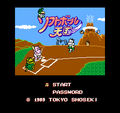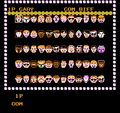
| Dusty Diamond's All-Star Softball | |
|---|---|
| Developer(s) | TOSE |
| Publisher(s) | Tonkin House (JP), Brøderbund Software (US) |
| Year released | 1990 |
| System(s) | NES |
| Genre(s) | Baseball |
|---|---|
| Modes | Single player, Multiplayer |
Dusty Diamond's All-Star Softball is a softball game developed by TOSE for the NES, and published in North America by Broderbund in 1990. It was originally published as Softball Tengoku (ソフトボール天国? lit. Softball Heaven) in Japan by Tonkin House in 1989. The game skews more towards an "arcade" sports game like Nintendo's Baseball than the more simulation-heavy baseball/softball games on the platform.
A feature of the game that few players would recognize is Team Building. Both players, simultaneously, select characters for their team. As there can be only one of each character used, and the players selecting do not have to take turns, there is a frantic meta-game in simply constructing a roster. One player could take all of the 'good' characters before the other player has even selected one. Every character has his or her own unique traits. Some are fast and some are slow. Some can hit really well and others can pitch really well. Some can teleport through a tag and others can even fly.
One thing that did not make the transition from the Japanese version to the US version is that all of the Japanese characters were mythical monsters or animals. While the US version has a little creativity with a devil and a witch character, the majority of the characters are nondescript everyday folks. Despite looking normal, all of the characters retain their original stats and powers. That makes it extremely difficult to figure out who is good at what. In the Japanese version, a player's characteristics gave you some clue as to what they might excel at. Discovering a player's strengths takes more trial and error in the North American version as a result.
-
Japanese box art
-
North American title screen
-
Japanese title screen
-
North American player select screen
-
Japanese player select screen
-
Game screen
Arenas[edit]
The game features 6 different "arenas" to play, each with their own features and ground rules:
- Sandlot: Based on a traditional sandlot, the field has areas with high grass and rocks with can interfere with a live play. To hit a home run, the player only has to hit a ball over the "home run line", not beyond the fence.
- Park: the area beyond the home run line has several park benches are trash cans with can interfere with the play.
- Cliff: The smallest field. Any ball that rolls under the picket fence in the right field is a ground rule double.
- School: Based on a schoolyard. A home run is scored if a ball goes over the home run line, but if it breaks a window on the school's building, it's an automatic out.
- Island: similar to a professional field, there are 2 small lakes in a foul territory which are out of play.
- Professional (in 2-player mode only, or in 1 player after defeating the computer in the 5 other levels): standard field.
The game also features a mercy rule, with the game ending if someone leads by 10 or more runs after an entire inning is played.






